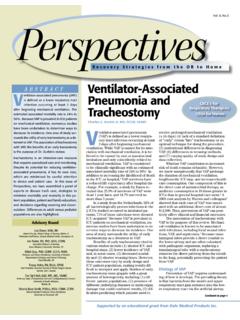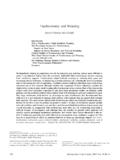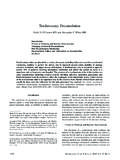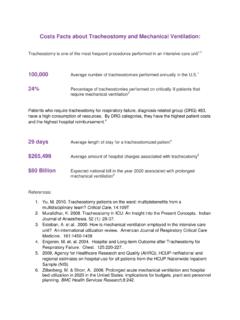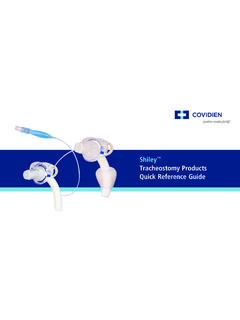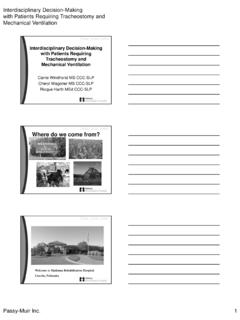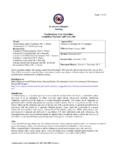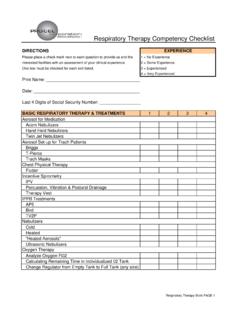Transcription of Vol. 10, No.2 Perspectives
1 PerspectivesRecovery Strategies From the OR to HomeVol. 10, on page 6 Jan Foster, RN, PhD, MSN, CCRNA ssociate Professor of NursingTexas Woman s University, Houston, TXMikel Gray, PhD, CUNP, CCCN, FAANP rofessor and Nurse PractitionerUniversity of Virginia Department of Urology and School of Nursing,Charlottesville, VATim Op t Holt, EdD, RRT, AEC, FAARCP rofessor, Dept. of Respiratory Care and Cardiopulmonary SciencesUniversity of South Alabama,Mobile, ALPaul K. Merrel, RN, MSN, APN-2 Advance Practice Nurse, Adult Critical CareUniversity of Virginia Health System,Charlottesville, NCJennifer A. Wooley, MS, RD, CNSDC linical Nutrition ManagerUniversity of Michigan Health SystemAnn Arbor, MIAdvisory BoardCEs for NursesCRCEs forRespiratory TherapistsGreat strides in reducing the incidence of ventilator-associ-ated pneumonia (VAP) have occurred since prevention bundles were introduced with the Save 100,000 Lives campaign by the Insti-tute for Healthcare Improvement (IHI).
2 Critical care units everywhere have ad-opted and monitor compliance with the elements of the bundle. Through the use of these actions, dramatic reduc-tions in VAP have been reported. Still, controversy exists over the scientific ba-sis of bundle elements1-3 and definitions of This article reviews the evidence supporting or questioning recommen-dations for VAP prevention published by the IHI and the Centers for Disease Control and Prevention (CDC). It will then explore the evidence-based prac-tices being implemented beyond the basic bundle including early tracheos-tomy and early mobility (including the ABCDE bundle ). The rationale, tech-niques employed to maintain patient safety, and an example of an early mo-bility program will be presented.
3 Tips for implementing a program will be Prevention BundlesThe VAP prevention bundles were first introduced by the IHI in 2004. Key components include elevation of the head of the bed, daily sedation vaca-tions paired with assessment of readi-ness to wean, peptic ulcer disease pro-phylaxis, and deep vein thrombosis prophylaxis. In 2008, O Keefe and col-leagues published the results of a 2-year study in the United States and Canada on the clinical outcomes of adherence to the bundle This study demonstrated that not only could venti-lator days and ICU length of stay (LOS) be reduced, but VAP rates could be re-duced as well. In 2010, the IHI added daily oral care with chlorhexidine based formulations after a literature review on research done in Europe was The IHI is not the only agency to publish data on a ventilator bundle.
4 The CDC7 and American Association of Critical Care Nurses (AACN)8 have also made recommendations for prevent-ing VAP. They endorse elevation of the head of the bed (HOB) and oral care, (including using a moisturizer) but also include eliminating routine ventilator circuit changes, use of an endotracheal tube (ETT) with continuous aspiration of subglottic secretions (CASS) and stress handwashing prior to any manip-ulation of the airway or circuit. Neither of these agencies has endorsed the use of chlorhexidine gluconate (CHG) for routine mouth care except for cardiac surgery patients, but AACN has issued a practice alert on techniques for oral Despite the apparent success of ven-tilator bundles in decreasing the inci-dence of VAP, controversy exists.
5 Realiz-ing the link between VAP and increased mortality, some authors question why the mortality rate from VAP has not sig-nificantly decreased due to bundle Others point to the lack of research supporting many of the ele-Fighting VAP one step at a time: Early mobility for the ventilated patientBy Lois K. Andrews, MSN, RN-BC, CCRN, ACNS-BCAccreditation Information This program has been approved for contact hours of continuing education (CRCE) by the AARC. AARC is accredited as an approver of continuing education in respiratory approved by the California Board of Registered Nursing. Provider #CEP 14477 Learning ObjectivesAfter reading these articles, the learner should be able to:1.
6 Compare the evidence supporting the bundle elements recommended for reducing VAP in the ICU patient2. Describe the modalities referred to as early mobilization 3. Discuss early versus late complications4. Describe methods to secure a tracheostomy tube5. Discuss how morbid obesity increases the risk of accidental cannulationTo Receive Continuing Education Credit 1. Read the educational offering (both articles).2. Complete the post-test for the educational offering. Mark an X in the box next to the correct answer 3. Complete the learner You may take this test online at www. , or you may mail or fax the completed learner evaluation and post-test to Saxe To earn contact hours of continuing education, you must achieve a score of 75% or more.
7 If you do not pass the test, you may take it again 1 Your results will be sent within 4 weeks after the form is The administrative fee has been waived through an educational grant from Dale Medical Products, Answer forms must be postmarked by Apr. 18, 2018 (Nurses) July 26, 2018 (RTs)Faculty DisclosuresNurse Planner: Lisa Caffery, MS, RN, CIC disclosed no conflicts of Experts: Lois Andrews MSN, RN-BC, CCRN, ACNS-BC; John Davies, MS, RRT, FAARC disclosed no conflicts of by Dale Medical Products procedure of tracheosto -my was formally documented first in the early 1900 A tracheostomy tube is used to secure the airway and its use reduces the chances of laryngeal injury.
8 It may also enhance weaning and allow for transfer to a step down unit or sub-acute care ,3 Since its incep-tion, tracheostomy has become one of the more frequently performed proce-dures in ICU care. It has been estimat-ed that 15-20% of ICU patients under-go tracheostomy at some point during their clinical ,5 tracheostomy offers several im-portant advantages over endotracheal intubation; 1) Lower airway resistance due to the shorter tube length, 2) Less dead space, 3) Less tube movement within the trachea, 4) Patient comfort, 5) More efficient suction, 6) Less risk of laryngeal and supraglottic injury, 7) Facilitation of easier patient mobiliza-tion and 8) Allowance of oral feeding and Over the years many technological advances have occurred both in terms of the procedure and the tracheos-tomy tube technology.
9 Unfortunately recent objective data describing com-plications are sparse and our gener-alized knowledge of complications is based on mostly dated literature. To that point, obesity has been on the rise in the last couple of decades and therefore very little association has been made between obesity and tra-cheotomy complications in this early literature. In this paper I will attempt to describe the types and incidences of complications in light of today s tech-nology and population distributions. Complications of tracheostomy Complications from trache-ostomy can be grouped into 3 time-referenced phases: intraoperative, early postoperative and late postop-erative.
10 Intraoperative complications include hemorrhage, air embolism, apnea, damage to adjacent structures and intraoperative fire. The focus of this paper, however, will be on early and late postoperative complications. It has been estimated that the rate of early postoperative complications is somewhere between - Late postoperative complication rate is more difficult to estimate accurately due to the presence of comorbid con-ditions, failure to yield clinically de-tectable symptoms and the fact that it is difficult to separate complications related to endotracheal intubation versus tracheostomy . Indeed, estimates of late postoperative complications range widely from to upwards of 65%.
